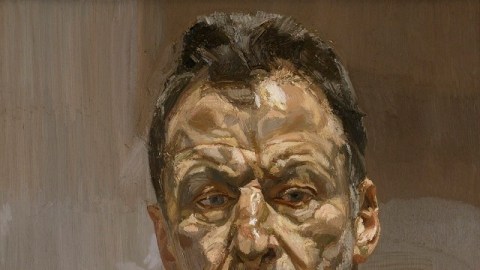How Lucian Freud painted himself by painting others

[mage: Lucian Freud. Reflection (Self-portrait), 1985 (detail). Copyright: Private Collection, Ireland, The Lucian Freud Archive. Photo: Courtesy Lucian Freud Archive.
“Nobody is representing anything,” Lucian Freud once said of all art, including his own. “Everything is autobiographical and everything is a portrait, even if it’s a chair.” Elsewhere, the grandson of Sigmund Freud announced that, “My work is purely autobiographical. It is about myself and my surroundings. It is an attempt at a record.”
When Lucian Freud died in July 2011, the current National Portrait Gallery, London, England, exhibition Lucian Freud Portraitswas already in the works. Along with the exhibition catalog and a smaller companion book, art historians are now trying to discern what Freud recorded about his inner self as he recorded the outward appearance of friends and family over the course of seven decades. Some felt that the portraiture as a relevant modern genre died with Freud, but this exhibition and these books make the case that the true value of these paintings — for him then and us today — lives on.
“Although many of [Freud’s] subjects have led complex lives,” Sarah Howgate, curator of contemporary portraits at the NPG, writes in the catalog to the exhibition, “most of them — with the exception of a few public figures — prefer to hold on to their anonymity. Lucian Freud Portraits is a life represented in paint rather than a biographical retrospective.” Despite the vividly illustrated chronology in the catalog (including the inevitable photo of Lucian with his famous granddad), this show is not about the who’s who of artists and other famous folk Freud painted over time.
Seeing Freud’s portraits collected together, the evolution in style is stunning. From the smooth early portraits of the late 1940s and early 1950s that earned him the title of “the Ingres of existentialism” from Herbert Read to the increasingly fleshier and fleshier portraits of the mid 1950s on, Freud surprises again and again. Howgate sees “a brusquer, more vigorous and liberated approach to painting” in the mid-1950s when Freud moved to coarser brushes and began painting standing up. “When I stood up I never sat down again,” Freud explained later. Physicality—of the brush, of the paint, of himself, and of his sitter—dominated the work ever after.
In the mid to late 1960s, Freud moved from painting mainly heads to painting whole bodies, especially nude figures at rest. The “voyeuristic aspect” of these sleeping nudes sometimes verges on the “predatory,” according to Howgate. In contrast to this picture of predatory Freud, we see Freud painting as loving son in several frankly honest portraits of his mother in her final years, including a sketch of her shortly after dying that clearly shows a dead and not a sleeping face. In what Howgate calls Freud’s “baroque phase,” the artist painted nude portraits of the plus-sized performance artist Leigh Bowery that Freud called “less autobiographical and, well, more ambitious, I suppose, in a sense.” Freud’s plus-sized female muse of this period, Sue Tilley, emerges “as feminine as a Rokeby Venusor a Manet nude, although far less idealized” in this study.
But even when these portraits seem to be about other people, Freud turned the focus back on himself. A series of brutally honest self portraits appears from the late 1960s and then makes a comeback in the 1980s and 1990s, when the artist reached his 60s and 70s. 1993’sPainter Working, Reflectionshows the 71-year-old artist completely nude save for a pair of open, unlaced boots as he wields a palette and palette knife in what may be the most brutally honest self-portrayal of aging this side of Rembrandt. In 1985’s Reflection (Self-portrait) (shown above), the intensity of Freud’s vision—the uncut, naked purity of his seeing, even of himself—bursts from the image. Howgate explains that one motivation behind Freud’s self-portraits was his own feeling of “obligation to understand the rigors of his process his sitters had to endure.” It is as if Shakespeare in his last plays were to give up putting monologues in the mouths of Hamlet, Lear, and others and took center stage himself.
Whereas the catalog to the exhibition shows Freud on the grand scale, the companion book Lucian Freud Painting Peopleprovides a smaller, more intimate look at the often intimidating artist. Martin Gayford, an art critic and friend of Freud, writes insightfully of the artist and his approach. Freud “was highly sensitive to the way that each sitter affected him,” Gayford explains. “Since each of them had a distinct presence and a particular physical and emotional output,” Gayford continues, “each made the things round about look a bit different to Freud.” In the end, each portrait reflects both the personality of the subject as much as Freud’s personality, capturing “something unique seen by someone unique.”
Where some see Freud almost coldly and cruelly cataloging the human condition, Gayford describes a Freud who interacts so deeply with his subject that the line between him and the other is nearly erased. David Hockney‘s tribute to his friend upon hearing the news of his death adds another dimension to the story of Freud as well. “He talked of other artists,” Hockney remembers from his time sitting for a portrait by Freud, “which was always insightful and entertaining and often bitchy but funny.” Freud found a fitting memorialist in Hockney.
In trying to explain Freud’s appeal for Americans, Michael Auping cites in the catalog Freud’s “otherness” to Americans, believing that “there is no true equivalent to Freud in America.” I agree that there’s no 20th century equivalent, but I think that a 19th century American artist offers, if not an equivalent, at least an interesting comparison. Thomas Eakins draws criticism for his unflatteringly honest portraits because some feel that he so thoroughly understood the inner workings of the human body that he couldn’t help but make every bone and sinew visible beneath the surface. Similarly, Freud fixates so thoroughly on the landscape of human flesh that every nuance seems telescoped as if a huge microscope were trained on every inch of skin. Just as Eakins takes heat for physically bringing the anatomical inner life to the surface, Freud suffers for giving a physical surface to the emotional and spiritual inner life. Only those who can’t withstand the honesty of their approaches would object.
When I look at the catalog to the exhibition Lucian Freud Portraits beside the smaller Lucian Freud Painting People, I know that the catalog captures the artist in the round, but that the pocket-sized book is the one that I’ll study closer. Sitting on subways, waiting in lines, taking random pauses during the day—those are the quiet times that I should study Freud’s art and, even more importantly, study his power of self-reflection. Each of us individually reflect the world and the people around us. The portraits of Lucian Freud, as examined in this exhibition and these books, provide a template for understanding how that reflexivity works and how we can be more attuned to both others and ourselves.
[Many thanks to the National Portrait Gallery, London, England, for the image above and other press materials from the exhibition Lucian Freud Portraits, which runs through May 27, 2012. Many thanks to Yale University Press for providing me with review copies of Lucian Freud Portraitsby Sarah Howgate with Michael Auping and John Richardson and Lucian Freud Painting People, introduction by Martin Gayford, appreciation by David Hockney, and foreword by Sarah Howgate.]




